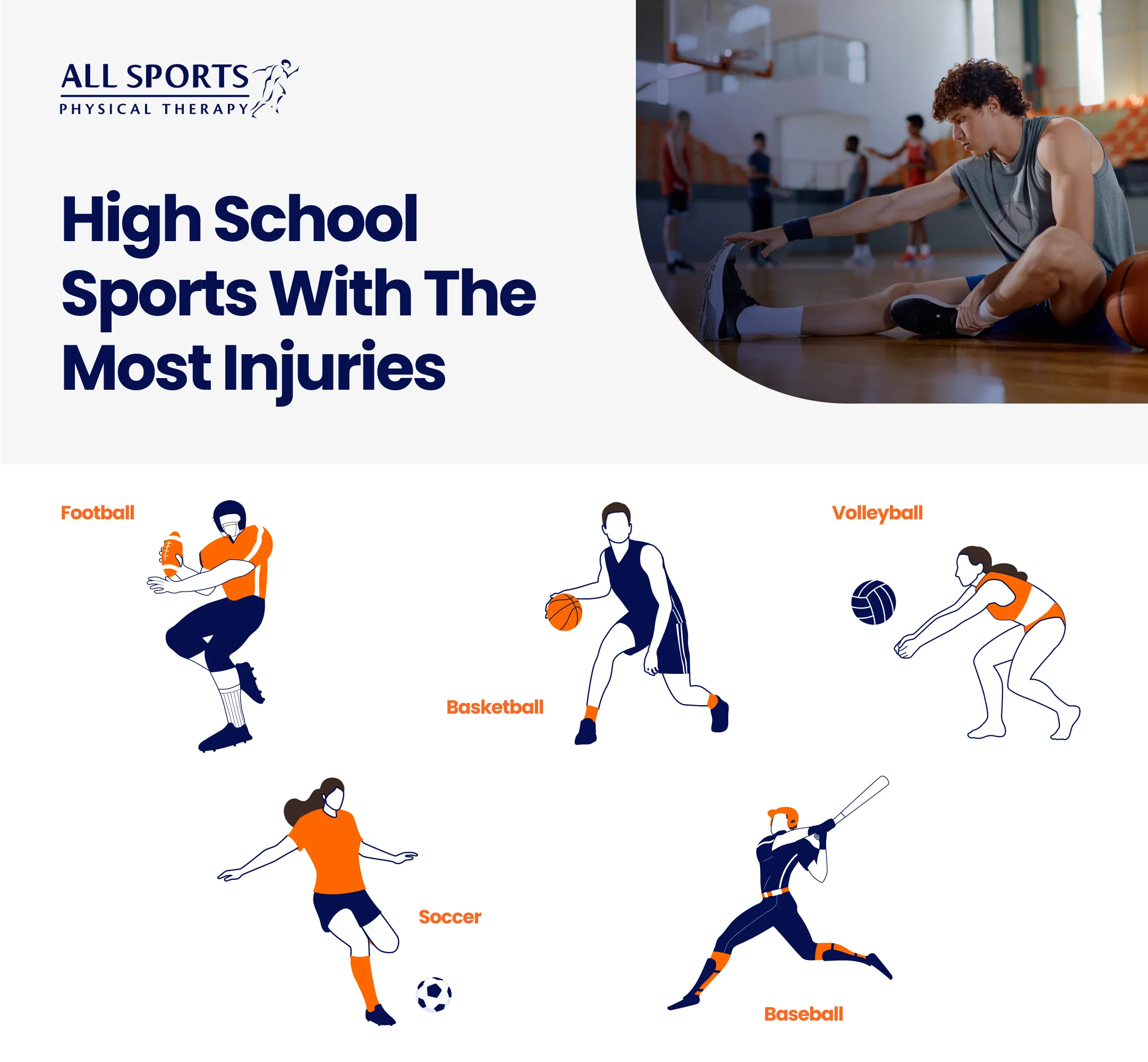High School Sports with the Most Injuries
Workout Injuries, Sports Medicine

High school sports are a great way to keep your child active, but they do have their risks.
For many high school students, returning to classes means not only getting back to loads of reading, writing, and math but also getting back on the playing field. A study by the National Federation of State High School Associations, an advocacy group for high school athletics, found that 7.8 million students participated in high school sports in the 2022-23 school year, an increase of nearly 240,000 from 2021-22.
While playing sports offers many benefits, such as sportsmanship and better cardiovascular conditioning, it also brings the risk of injury. Because students’ bones have not yet fully developed, they stand a greater chance of injury. Therefore, many parents and teens are rightly concerned about which high school sports have the most injuries. So let’s look at some high school sports injury statistics to bring awareness to the potential dangers of each sport and how to best avoid injuries.
High school sports injuries: What the numbers say

From football and soccer to basketball and volleyball, high school students have a wide range of sports to choose from. A study on high school sports injuries presented at the 2023 meeting of the American Academy of Orthopaedic Surgeons reviewed reports of injuries in five boys’ sports (football, soccer, basketball, wrestling, and baseball) and four girls’ sports (soccer, basketball, volleyball, and softball).
A total of 15,531 injuries during 6,778,209 athletic exposures (AEs) were reported by athletic trainers. That translates to an overall rate of 2.29 injuries per 1,000 AEs. Here’s what that study and others revealed about which sports had the most injuries:
Football
According to the AAOS report, football had the highest injury rate, at 3.96 per 1,000 AEs. A 2018-2019 National High School Sports-Related Injury Surveillance Study also gave football the top spot, with 455,449 injuries related to that sport that year. The most common type of injury was a tear to the ACL (anterior cruciate ligament) in the knee.
Soccer
The AAOS study found girls’ soccer produced the second-highest injury total, at 2.65 per 1,000 AEs. However, when girls' and boys’ soccer injuries were added together, the total came to an alarming 412,607 cases, per the National High School Sports-Related Injury Surveillance Study. The most common soccer-related injury was a concussion.
Basketball
The National High School Sports-Related Injury Surveillance Study found playing basketball (both girls and boys) accounted for 169,904 injuries, with jammed fingers a common injury.
Volleyball
Between quick turns, powerful jumps, and strong serves, volleyball had an injury rate of 1.34 per 1,000 AEs during the 2018-2019 school year, according to the National High School Surveillance Study. This amounts to 59,370 volleyball injuries nationwide. The same study shows that a large portion of injuries occurred in the ankle, wrist, and hands, with sprains and strains keeping most players off the court.
Baseball and Softball
According to the National Safety Council, baseball and softball accounted for 39,981 injuries in teens and young adults between the ages of 15 and 24 in 2022 alone. Additionally, upper leg strains and concussions were the leading diagnoses for high school athletes from 2018-2019.
While sports can be dangerous, your teen can still enjoy their athletic hobbies if they take the proper precautions to minimize the risk of developing severe injuries.
Preventing high school sports injuries
High school sports injuries can either be acute (a temporary injury like a broken bone or ligament tear) or chronic due to overuse, such as shoulder and elbow injuries from throwing overhand. Fortunately, there are some measures parents and students can take to lessen the chance of an injury:
- Stay in shape year-round. Many students take the summer off from playing, which can stiffen the muscles and joints. When they return to the playing field, their bodies aren’t geared up for the grind, making injuries more likely to occur. Encourage your child to stay active year-round to keep their bodies nimble and strong.
- Play more than one sport. Not only does playing several sports build all-around athletic skills, but it can also prevent injuries in underused areas of the body.
- Warm up before playing. Get your child into the habit of warming up their muscles before the game.
- Don’t play through pain. If your child is hurting, take them to a doctor or physical therapist for an examination. The doctor can diagnose the injury, if there is one, and recommend ideal treatment options so they can get back to playing their favorite sport.
Stay in the game with our therapists
At All Sports Physical Therapy, we know how important sports are to your child. Our therapists will help your child get back in the game after an injury. Using the latest in physical therapy techniques, we’ll keep your child playing throughout his or her high school years without the pain. Contact us today for a consultation.
References:
1. Pizzarro J, Chiang B, Malyavko A, et al. Epidemiology of Sports Injuries Among High School Athletes in the United States: Data From 2015 to 2019. Orthopaedic Journal of Sports Medicine. 2024;12(5). doi:10.1177/23259671241252637
2. Comstock, R., & Pierpoint, L. (2018). SUMMARY REPORT NATIONAL HIGH SCHOOL SPORTS-RELATED INJURY SURVEILLANCE STUDY. https://coloradosph.cuanschutz.edu/docs/librariesprovider204/default-document-library/2018-19.pdf?sfvrsn=d26400b9_2
3. National Safety Council analysis of U.S. Consumer Product Safety Commission NEISS data. National Safety Council. Injury Facts®.



